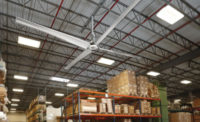
1) Chronic spinal injuries: “Trailer drop,” or vertical semi-trailer bed movement, occurs with the weight of lift trucks traveling in and out of trailers. Trailer drop causes lift truck operators to experience significant jolts, which can lead to chronic back and neck injuries. Trailer beds can move vertically, or drop, up to 8 inches during the loading and unloading process. Restraints that stabilize the trailer to prevent both vertical and horizontal movement address the risk of chronic spinal injuries.
2) Vibration: Operators of lift trucks (forklifts or stand-up walkies) often experience significant jarring known as “dock shock” due to the bumps and gaps that exist on traditional dock levelers as they cross between the warehouse floor and the trailer bed. The risk can be minimized with levelers that create a smooth path for lift trucks traveling in and out of trailers.
3) Vacant docks: Many dock levelers aren’t designed to keep a forklift from falling off the edge of a vacant dock with catastrophic results. The issue can be addressed with a steel barrier on the leveler, which automatically moves into position after trailer loading and unloading to form a protective lip at the dock edge. Vacant docks also pose a safety risk for pedestrians and operators of pallet jacks.
4) Trailer separation: Catastrophic accidents occur when a trailer separates from the dock during the loading and unloading process. Vehicle restraints address the issue by securing the rear impact guard (RIG) of trailers to the dock. However, not all vehicle restraints are alike — and not every restraint protects against all types of dock separation incidents. A good practice is to use a restraint with a “hook” that wraps around the RIG to protect against every known form of catastrophic accident associated with trailer separation.
5) Dock fires: Incidents stem from a fire hazard involving dock seals and semi-trailer marker lights: it has been proven that burning can occur when hot-running semi-trailer lights are compressed against any make or model of compression-style foam dock seals. Advanced dock seal technology, such as those with heat-dissipating, triple-layer foil technology incorporated into dock seal head pads, head curtains and side pads, means the seals are fire-resistant and will prevent them from catching on fire. Fire-resistance prevents fire from occurring. A fire-retardant solution, however, means the materials must actually begin to burn before they work.
6) Industrial door accidents: Leading door manufacturers have introduced a host of safety devices to ensure their safety. The devices range from basic warning labels to reversing-edge mechanisms to photo-eye sensors to flexible bottom edges to area-detection systems. Other common safety devices include warning signals and vision panels. Choosing a high-speed door designed around safety is a prerequisite for virtually any material-handling environment.
